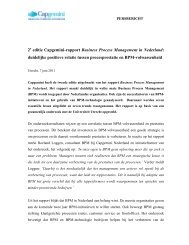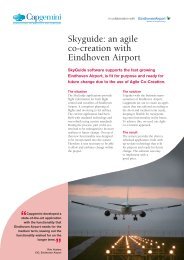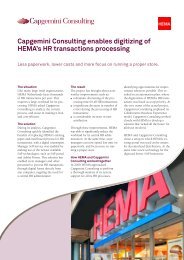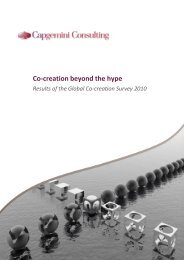IT transformations - Capgemini Consulting Nederland
IT transformations - Capgemini Consulting Nederland
IT transformations - Capgemini Consulting Nederland
You also want an ePaper? Increase the reach of your titles
YUMPU automatically turns print PDFs into web optimized ePapers that Google loves.
have in terms of driving revenues<br />
and minimizing Intellectual Property<br />
(IP) theft. We also present insights<br />
from <strong>Capgemini</strong>’s primary research<br />
of key content industry players<br />
across Europe 2 . We conclude with a<br />
set of recommendations for content<br />
providers.<br />
Challenges Facing the Content<br />
Industry<br />
Content players globally are facing<br />
significant challenges through a<br />
combination of changing consumer<br />
behavior, evolution of technology, and<br />
piracy. These challenges create the<br />
need to continuously innovate, pursue<br />
new business models, and effectively<br />
apply law enforcement.<br />
Consumers Expect Content to be<br />
Priced Free<br />
A key reason for the rapid uptake<br />
of web services has been the largely<br />
free content provided initially.<br />
The New York Times and The Times<br />
originally encouraged free access<br />
to their websites while charging for<br />
print editions. After gaining traction,<br />
they are now attempting to create<br />
paywalls around their websites. User<br />
perception, however, is still at the<br />
price point of zero (see Figure 2).<br />
Moreover, the ease and convenience<br />
in transferring digital content<br />
has led consumers to have a poor<br />
appreciation of the inherent costs<br />
of the content owners. Industry<br />
players now have the challenge of<br />
changing this perception and creating<br />
pricing models that will viably entice<br />
customers.<br />
New Consumption Patterns are<br />
Evolving<br />
The proliferation in devices such<br />
as smartphones, tablets and Digital<br />
Video Recorders (DVRs) and<br />
the increasing fixed and mobile<br />
bandwidth are driving consumption<br />
pattern changes. Consumer attention<br />
spans have shrunk. In a survey<br />
published in June 2010 short-form<br />
videos were the most popular in eight<br />
out of ten genres 3 . Multi-tasking is<br />
widespread with 59% of US citizens<br />
using the TV and the Internet<br />
simultaneously 4 .<br />
Customers also demand more<br />
flexibility in consumption, and some<br />
industry players are beginning to<br />
address that. For instance, Amazon’s<br />
Kindle automatically synchronizes the<br />
last page read between devices letting<br />
consumers to move seamlessly from<br />
a PC to a dedicated e-book device to<br />
a smartphone. Similarly, <strong>Capgemini</strong>’s<br />
research indicates that Video on<br />
Demand (VoD) to be a priority for<br />
content companies 5 .<br />
Barriers to Piracy are Low and the<br />
Impact Multi-faceted<br />
Efficient digital file formats and<br />
the ubiquity of the Internet have<br />
enabled easy access to a large variety<br />
of content. For the end-consumer,<br />
piracy is seen as an effective option<br />
because of cost, convenience, and the<br />
perceived anonymity.<br />
For companies though, the full impact<br />
of piracy goes beyond the direct<br />
revenue loss. Piracy puts pressure<br />
2 <strong>Capgemini</strong> conducted detailed primary research with select content industry senior executives on a wide-ranging array of<br />
matters related to the spread of digital content; the need to protect intellectual property; the impact of piracy on business<br />
models; and various other related questions. The survey was conducted in mid-2010 across major European markets.<br />
3 Frank N. Magid & Associates, Magid Media Futures 2010: Online Video, June 2010.<br />
4 Nielsen, Three Screen Report, Q1, 2010.<br />
5 <strong>Capgemini</strong> Primary Research, 2010.<br />
Figure 2: Survey Response to Question “Free content on the Internet should<br />
remain free”, Global, 2009 *<br />
100%<br />
90%<br />
80%<br />
70%<br />
60%<br />
50%<br />
40%<br />
30%<br />
20%<br />
10%<br />
0%<br />
86%<br />
12%<br />
2%<br />
67<br />
80%<br />
16%<br />
4%<br />
89%<br />
11%<br />
87%<br />
11%<br />
Total Asia Pacific Europe Middle East,<br />
Africa, Pakistan<br />
Strongly Agree/Agree<br />
Neither Agree nor Disagree<br />
92%<br />
8%<br />
89%<br />
“<br />
Changes<br />
in consumer<br />
behavior and<br />
expectations<br />
coupled with low<br />
technological<br />
barriers to<br />
piracy are some<br />
of the biggest<br />
challenges<br />
for content<br />
players<br />
”<br />
10%<br />
1% 2% 1% 1%<br />
Latin America<br />
Disagree/Strongly Disagree<br />
* Note: The numbers may not add up to 100% due to rounding errors.<br />
Source: Nielsen, Changing Models: A Global Perspective on Paying for Content Online, February 2010<br />
North America
















